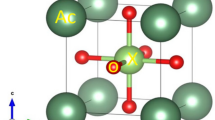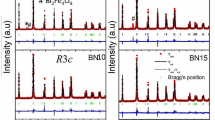Abstract
The effect of glass composition on the electrical conductivity and dielectric permittivity of Eu-activated Pb-containing fluoroaluminate glasses is studied. The Arrhenius plots of resistivity in the range 383–653 K are used to evaluate the activation energy for conduction, which is found to decrease with increasing PbF2 content. The results are interpreted as evidence that the glass network undergoes drastic structural changes as the PbF2 content increases to above 15 mol %. The induced-absorption band around 780 nm, due to radiation-produced defects incorporating Pb2+, O2–, and F– ions, is shown to be sensitive to the glass-network-forming behavior of Pb. The introduction of Eu2O3 suppresses this induced absorption, indicating that the color centers responsible for it have an electronic nature.
Similar content being viewed by others
REFERENCES
Lucas, J. and Adam, J.L., Halide Glasses and Their Optical Properties, Glastech. Ber., 1989, vol. 62, no. 12, pp. 422–440.
Adam, J.L., Fluoride Glass Research in France: Fundamentals and Applications, J. Fluorine Chem., 2001, vol. 107, pp. 265–270.
Jestin, Y., Le Sauze, A., Boulard, B., et al., Viscosity Matching of New PbF 2 –InF 3 –GaF 3 Based Fluoride Glasses and ZBLAN for High NA Optical Fiber, J. Non-Cryst. Solids, 2003, vol. 320, pp. 231–237.
Khalilev, V.D. and Anisonyan, L.D., Oxygen-Free Uso-vite-Based Fluoroaluminate Glasses, Fiz. Khim. Stekla, 1985, vol. 11, no. 6, pp. 734–737.
Khalilev, V.D., Chekhovskii, V.G., Bogdanov, V.L., et al., Crystallization of Usovite-Based Glasses, Fiz. Khim. Stekla, 1993, vol. 19, no. 2, pp. 293–306.
Bocharova, T.M., Grigoryan, T.M., Karapetyan, G.O., and Khalilev, V.D., Optical Properties of Gamma-Irradiated Pb-Containing Fluoroaluminate Glasses, VII Vse-soyuznyi simpozium po opticheskim i spektral'nym svoistvam stekol (VII All-Union Symp. on Optical Prop-erties of Glasses, Leningrad, 1989), Leningrad: Gos. Opticheskii Inst., 1989, p. 313.
Bocharova, T.V., Tagil'tseva, N.O., and Khalilev, V.D., Effect of Ionizing Radiation on Europium-Containing Fluoroaluminate Glasses Activated with CeF 3, TiO 2, V 2 O 5, CrF 3, and CuF 2, Neorg. Mater., 1999, vol. 35, no. 1, pp. 94–98 [Inorg. Mater. (Engl. Transl.), vol. 35, no. 1, pp. 78–81].
Bocharova, T.V., Karapetyan, G.O., Tagil'tseva, N.O., and Khalilev, V.D., Postirradiation Behavior of Rare-Earth-Activated Fluoroaluminate Glasses, Neorg. Mater., 2002, vol. 38, no. 12, pp. 1525–1532 [Inorg. Mater. (Engl. Transl.), vol. 38, no. 12, pp. 1302–1308].
Gee, I.A., Holland, D., and McConville, C.F., Atomic Environments in Binary Lead Silicate and Ternary Alkali Lead Silicate Glasses, Phys. Chem. Glasses, 2001, vol. 42, no. 6, pp. 339–348.
Coon, J. and Shelby, J.E., Properties and Structure of Lead Fluorosilicate Glasses, J. Am. Ceram. Soc., 1988, vol. 71, no. 5, pp. 354–357.
Gressler, C.A. and Shelby, J.E., Properties and Structure of PbO–PbF 2 –B 2 O 3, J. Appl. Phys., 1989, vol. 66, no. 3,pp. 1127–1131.
Shaw, C.M. and Shelby, J.E., Effect of Lead Compounds on the Properties of Stannous Fluorophosphate Glasses, J. Am. Ceram. Soc., 1988, vol. 71, no. 5, pp. 252–253.
Khalilev, V.D. and Bogdanov, V.L., Fluoride Glasses, Zh. Vses. Khim. O–va. im. D. I. Mendeleeva, 1991, vol. 36, no. 5, pp. 593–602.
Fedorov, P.P., Crystal-Chemical Aspects of Fluoride Glass Formation, Kristallografiya, 1997, vol. 42, no. 6, pp. 1141–1152.
Fedorov, P.P., Glass Formation Criteria for Fluoride Systems, Neorg. Mater., 1997, vol. 33, no. 12, pp. 1415–1424 [Inorg. Mater. (Engl. Transl.), vol. 33, no. 12, pp. 1197–1205].
Ignat'eva, L.N., Quantum Chemistry and Vibrational Spectroscopy of Fluoride Glasses: Structure and Principles of Formation, Doctoral (Chem.) Dissertation, Vladivostok, 2000.
Khalilev, V.D., Karapetyan, K.G., Bogdanov, V.L., et al., Structure and Properties of Usovite-Based Fluorophosphate Glasses, Fiz. Khim. Stekla, 1990, vol. 16, no. 4, pp. 529–533.
Mazurin, O.V., Electrical Properties of Glass, Tr. Len-ingr. Tekhnol. Inst. im. Lensoveta, 1962.
Andreev, N.S., Mazurin, O.V., Porai-Koshits, E.A., et al., Yavlenie likvatsii v steklakh (Phase Segregation in Glass), Leningrad: Nauka, 1974.
Sorokin, N.I., Fedorov, P.P., Zakalyukin, R.M., et al., Electrical Conductivity of PbF 2-and InF 2-Based Fluo-ride Glasses, Neorg. Mater., 1999, vol. 35, no. 1, pp. 88–93 [Inorg. Mater. (Engl. Transl.), vol. 35, no. 1, pp. 72–77].
Khalilev, V.D., Tarlakov, Yu.P., Petrosyan, B.V., and Pronkin, A.A., Electrical Conductivity and Structure of Ba(PO 3 ) 2 –AlF 3 –LiF Glasses, Fiz. Khim. Stekla, 1983, vol. 9, no. 2, pp. 190–194.
Anisimov, V.A., Dmitryuk, A.V., Karapetyan, G.O., and Maksimov, L.V., Structural Study of Rare-Earth Phosphate Glasses by Spectral–Kinetic Techniques and Light Scattering Spectroscopy, Stekloobraznoe sostoyanie (Glassy State), Leningrad: Nauka, 1983, pp. 62–70.
Wong, J. and Angell, C.A., Glass Structure by Spectros-copy, New York: Marcel Dekker, 1976.
Bishay, A., Radiation Induced Color Centers in Multi-component Glasses, J. Non-Cryst. Solids, 1970, vol. 3, pp. 54–114.
Bocharova, T.V. and Karapetyan, G.O., Radiation-Induced Processes in Lead Phosphate Glasses, in Razrabotka elementov gibridnykh integral'nykh skhem opticheskogo i millimetrovogo diapazonov (Components of Hybrid Integrated Circuits for the Optical and Milli-meter-Wave Ranges), Tula: Tul'sk. Pedagogich. Inst., 1985, pp. 21–25.
Lunter, S.G. and Fedorov, Yu.K., Color Centers in Neodymium Phosphate Glasses and Their Spectroscopic Properties, Fiz. Khim. Stekla, 1988, vol. 14, no. 1, pp. 72–78.
Raaben, E.L. and Tolstoi, M.N., Effect of the Nature of Glass Formers and Modifiers on the Absorption Spectrum of Pb Ions, Fiz. Khim. Stekla, 1988, vol. 14, no. 1, pp. 66–71.
Dmitryuk, A.V., Karapetyan, G.O., and Maksimov, L.V., Activator Segregation and Its Spectroscopic Signatures, Zh. Prikl. Spektrosk., 1975, vol. 22, no. 1, pp. 153–182.
Author information
Authors and Affiliations
Rights and permissions
About this article
Cite this article
Bocharova, T.V. Properties and Structure of Eu-Activated Pb-Containing Fluoroaluminate Glasses. Inorganic Materials 40, 1105–1110 (2004). https://doi.org/10.1023/B:INMA.0000046478.94799.fe
Issue Date:
DOI: https://doi.org/10.1023/B:INMA.0000046478.94799.fe




